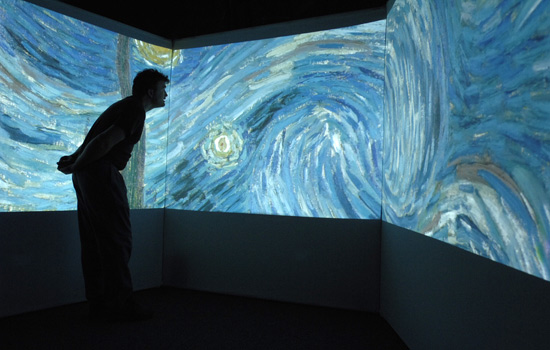College of Science offers new interactive learning techniques
A. Sue Weisler | photographer
A variety of immersive and wide-view large projection displays will be showcased at Imagine RIT. This prototype immersive classroom will be on display in the Link Building.
RIT’s College of Science is immersed in creativity. A simple idea to wallpaper classrooms with images, movement and sound using digitally networked projectors has taken hold and is inspiring professors across campus to dive into a new way of teaching.
Collaborations are ongoing with researchers in the B. Thomas College of Information and Computing Sciences, the College of Imaging Arts and Sciences and the College of Liberal Arts. The approach is simple, flexible and easily adapted to traditional learning environments and more experimental, active classrooms that incorporate screen displays in either open or cube-like configurations.
“The basic simple idea is that surrounding people with big pictures and sound is a very engaging way of interacting with them,” says Ian Gatley, dean of the College of Science. “We can use it for teaching or for entertaining.”
Gatley first suggested the idea to the Rochester Museum and Science Center as a way to upgrade its planetarium projection technology. Gatley, who chairs a task force at the museum and science center, looked into the technology and saw potential applications at RIT.
“There’s more you can do within the spaces they’re used to working in,” says Mitchell Rosen, research professor in color science and director of the iPixLab, the Infinite Pixel Liberation Laboratory, where the projection technology is explored.
A variety of immersive and wide-view large projection displays were showcased at Imagine RIT. The Gosnell Building, for instance, housed the RIT Immersive Theater in the Van Peursem Auditorium and a huge flat screen over the atrium. Prototype immersive classrooms were in the Link Building and in Wallace Library, A400, where the “Collabortorium” was to be on display.
“It’s very, very difficult to get high schoolers impressed by anything technological these days,” Rosen says. When using this technology for high school open houses, Rosen says, “we get an auditorium full of high school seniors who are absolutely engaged. This tells us we have stumbled upon something worth pursuing.”
According to Rosen, this kind of large projection technology is starting to attract attention from companies and other universities. RIT, he says, is ahead of the wave. “RIT has the technologists who understand the capture, the manipulation and the presentation of imagery,” he says. “But at the same time we have that creative army of young adults who are just waiting to take off the shackles. And we know that whenever something like that comes along—like YouTube, like other aspects of instant sharing of media—we know that they jump straight in. “And now, what we’re saying is, ‘You’re no longer constrained to that rectangle on the desk or that rectangle on the wall. The walls are now alive. The desktops are now truly available to you. Everything in the room can be painted by this technology, even your friend’s shirt for that matter.’”















